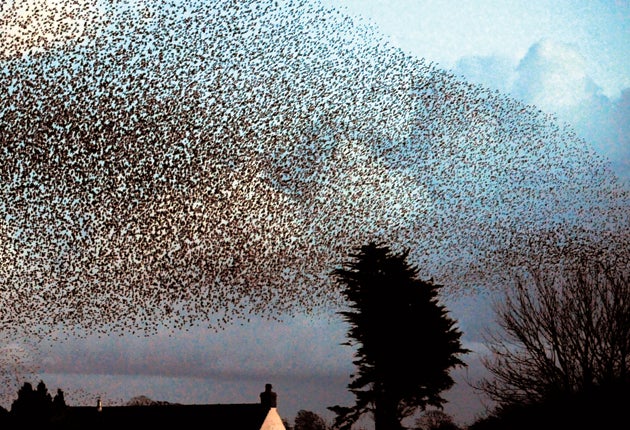Revealed: the mechanism that allows birds of a feather to flock together
Pigeons loaded with GPS backpacks show the secrets of co-ordinated flight control

Anyone interested in the democratic process could do worse than study the group decisions made by pigeons in mid-flight. Scientists have discovered that pigeon flocks are governed by a kind of "democratic hierarchy" that makes sure everyone flies in the same direction.
With the help of tiny GPS backpacks carried by each member of a loft of pigeons, researchers have discovered how large numbers of animals are able to instantly co-ordinate their movements to ensure that they do things as a group rather than as anarchic individuals.
Although the principle has so far only been demonstrated with a smallish flock of Hungarian pigeons, the scientists believe it could also operate on much bigger groups of animals, such as schools of fish and herds of wild buffalo, and might even explain how close-knit groups of people, such as juries, manage to reach a single decision.
"Anyone who has seen flocks of birds or schools of fish is familiar with this phenomenon of large numbers of individuals in a fast-moving group appearing to move in a co-ordinated way, and it's not immediately clear how they coordinate themselves," said Dora Biro, a zoologist at Oxford University.
"Our question was, how do groups like flocks of pigeons make decisions about what to do and where to go?" Dr Biro said.
The GPS backpacks carried by the pigeons enabled the scientists to precisely monitor the birds' movements, relative to each other, every 0.2 seconds of their journey from the point where the scientists released them to their home loft in Budapest, 15km away.
"Previously, people had assumed democratic decisions, where every bird's preferences are somehow averaged out, and that's what the group ends up doing. Or there might be a single leader or a small number of leaders that everyone follows," Dr Biro said.
"But what we were able to do by tracking these birds with individual GPS units was to resolve the leader-follower relationship within the flock. What we found was a more sophisticated and refined mechanism for how the decisions are made," she said.
"There wasn't a single leader, nor was there a kind of egalitarian decision-making where everyone had an equal vote. Instead, each bird did have a vote, but the weight that each vote carried differed between birds.
"It represented a kind of hierarchy where the decisions of some birds near the top of the hierarchy carried more weight in terms of what the birds did than the birds lower down the hierarchy, who were still influential but to a lesser degree," said Dr Biro, who carried out the study with Tamás Vicsek of Eötvös University in Budapest.
"Whether such effects come from some individuals being more motivated to lead, or being inherently better navigators perhaps with greater navigational knowledge, is an intriguing question we don't yet have an answer to," Dr Biro said.
The loft of pigeons in the study consisted of 10 birds whose every movement was recorded as they flew in a flock from one location to another. The analysis, published in the journal Nature, described how each bird moved in relation to its neighbours, with some individuals leading more than others.
"It's neither a completely democratic system, where everybody gets the vote, nor [one with] a single leader or a few leaders responsible for the decisions. But in fact every individual gets a kind of input into what the group as a whole should do," Dr Biro said.
"If this was honed by evolution, if there was a selective advantage for individuals in the group to make decisions in this way, then it might represent a particularly efficient form of group decision making... It is possible that the mechanism we saw in these pigeons generalises to other species and to other group decision-making contexts, even in humans," Dr Biro said.
Subscribe to Independent Premium to bookmark this article
Want to bookmark your favourite articles and stories to read or reference later? Start your Independent Premium subscription today.

Join our commenting forum
Join thought-provoking conversations, follow other Independent readers and see their replies